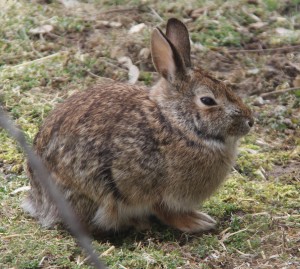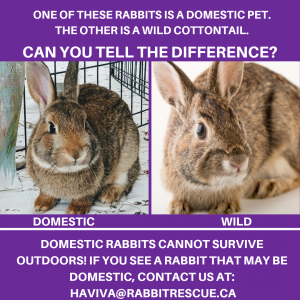Domestic VS Wild Rabbits in Southern Ontario, Canada
Respecting or neglecting the unique environmental, dietary and psychological needs of a domesticated rabbit versus a wild rabbit can mean life or death (or at the least, quality and/or quantity of life) for that individual rabbit. Domesticated rabbits can be provided with long, enriched lives as companions inside our homes, whereas wild rabbits are equipped to live outside and have not gone through the domestication process.
Domestication, is the process of generations of selective breeding creating a dependency on humans and takes away that species’ ability to survive independently outside. Both domestic and wild rabbits are prey species which means that reading their stress levels, health condition, behaviour and ultimately their ongoing quality of life can be difficult to assess by the untrained eye. Yet the behaviour and interaction between wild rabbits and humans versus domestic rabbits and humans can be drastically different and obvious in normal situations. Domestics have the ability to interact with their trusted humans to the same degrees as the relationships and interactions we have with our companion cats and dogs. This would not be a typical encounter with a wild rabbit.
Wild rabbits requiring medical or behavioural assessments and treatment, including babies once they are confirmed to be orphaned, can receive the necessary help through licensed wildlife rehabilitators. Ontario’s Ministry of Natural Resources and Forestry regulates these rehabilitators and the goal is to return native species to a natural life in the wild once recovered and/or old enough.
The first step in helping a rabbit in need is understanding how to tell domestics apart from wild rabbits generally by their appearance and not always behaviour. Domestic rabbits can sometimes escape from a home or outdoor enclosures (not recommended!) but more often than not, are abandoned outside by humans. Just because they are found outside, does NOT mean they are a wild species. And just because you take a wild rabbit inside, this does not magically turn them into a domesticated species. There are what seem like an endless amount of domestic animals, including rabbits, requiring homes. These amazing companions don’t have the option of living outside whereas healthy wildlife thrive outside of captivity. Wild rabbits do poorly indoors, they never adapt, it is illegal for most vets to treat them, and it is also illegal to house them without a wildlife permit.
Scientific classification (Taxonomy)
Rabbits, hares and pikas are small mammals in the family Leporidae of the order Lagomorpha. In order to begin understanding the difference between domesticated rabbits and their wild counterparts, it can be helpful to look at how they are further divided into different classifications, specifically their genus and species.
While The American Rabbit Breeders Association Inc. currently recognizes 49 standard domestic rabbit breeds, there are at least 305 breeds of domestic rabbits in 70 countries around the world. A “breed” refers to the different varieties of domestic animals of the same species. Here in southern Ontario (south of the northernmost point of Lake Superior) the more commonly found native wild rabbit species living in close proximity to people is the Eastern cottontail. Snowshoe hares and European hares (the later being native to Europe but introduced to Ontario as game animals/for hunting) can also be found in this region. So there are literally hundreds of different domestic rabbits that can be found and only one common wild species in the more urban areas of this region.
Fur Colours, Length & Markings
Rabbits can vary greatly in colouring but it is only the domesticated rabbit that can found in solid colours (and mixes) including: black, year-round white, grey, brown, orange, red etc. As well, it is only domestics that will be found with very distinct fur patterns such as spots and lines. Their wild counterparts in southern Ontario, the Eastern cottontail and European hare, will always be and speckled or peppered brownish-red over entire top of body (which more specifically is a mix of small specks of brown, white, orange/red, grey and black throughout most of their body) with the purpose of being able to easily camouflage into an outdoor environment. The third type of wild species of rabbit found in southern Ontario is the Snowshoe hare who also comes in the same kind of even brown over entire top of body, with their fur colouring changing to white to camouflage better during colder months in snow. It is true that some domesticated (companion animal) rabbits can come in almost this exact same speckled brown colouring – which is when it can be most confusing to tell them apart.
Some domestic rabbits can have longer or more decorative fur such as angoras or lionheads whereas a wild rabbit’s fur will be more uniform (and shorter than the fancy domestic breeds) throughout their entire body and is a lot more utilitarian. In cold weather, the Easter Cottontail can appear to have fluffier fur. The fur of a domestic can look a lot fluffier or softer than the fur of an adult cottontail which will appear more coarse and sleek. Baby wild rabbits are typically found with a little white patch of fur on their foreheads, although some domestics can be found with a similar obvious spot.
Size & Ear Positioning
The size or weight of domestic rabbits can vary drastically, with some (the Flemish giant) reaching upwards of 22 pounds and measuring about 4 feet long. Adult Eastern cottontails are about 15-18 inches long and weigh between 2 and 3 pounds on average. If the rabbit has ears hanging down, as in a lop-eared rabbit, it is domestic.
Warrens & Nests
Domestic rabbits trying to cope outside will dig down into the earth to have their babies in warrens (or deep underground holes and tunnels), similar to the wild European rabbits. Eastern cottontail mothers instead create a very shallow depression in the ground where barely furred and eyes closed babies lay at ground level but covered by bits of their mother’s fur and grass. Snowshoe and European hare babies are born fully furred with their eyes open in a protected area of brush or grass and have very different life stages than Eastern cottontail babies.
Behaviour
More often than not, appearance over behaviour is used to determine the difference between the two. A timid, scared or cautious domestic rabbit found outside can sometimes act very similar to a wild species. Both domestic and wild rabbits can be equally difficult to catch or just as easy, depending on the circumstances. A wild rabbit that appears friendly or is easy to contain, may be suffering from a life threatening illness or injury. A domestic rabbit that can be extremely difficult to catch is not necessarily coping very well in other aspects. Eastern cottontails will often nest in backyards or schools, even directly outside of homes that have pet dogs that frequent the yard. A common and serious problem occurs when very young Eastern cottontail babies are taken into captivity at an early age and can suffer short and long term from habituation and sometimes irreversible damage from imprinting. If a baby Eastern cottontail found outside of the nest is not able to escape predators (including humans) this could be an indicator that something is wrong. For more info on what do if you suspect an orphaned cottontail, click HERE.
Allowing for each of these species, whether domestic or wild, to live natural and fulfilling lives in their respective environments with the right kind of attention, leads to happier rabbits and better outcomes for all.
If you suspect an injured WILD rabbit, please contact a wildlife rehabilitator. For a list of ones in Ontario, click HERE.
If you are unsure if a rabbit you have seen outdoors is wild or domestic, snap a pic and send it to us.
Were you able to determine which is wild and which is domestic?The rabbit on the left is domestic. His name is London and he was saved by RR volunteers after being dumped outside. The rabbit on the right is an Eastern Cotton Tail.









